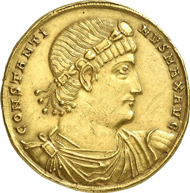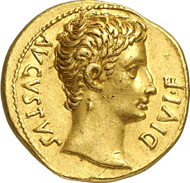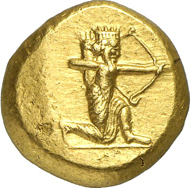13-10-2013 – 17-10-2013
Auction sales 215-217
Roman gold medallion at Gorny & Mosch yields 644,000 euros!
26.77 g is the weight of the probably most expensive coin sold at Munich ever. This coin is a very particular one, a special emission issued on the occasion of the reigning anniversary of Constantine the Great. On its obverse it shows the bust of the emperor with a diadem. On the reverse, two winged Victories hold a wreath with VOT / XXX written within.
Nr. 1095. Roman Imperial Times. Constantine I the Great, 307-337. Multiple piece, July 335, Nicomedia. Unpublished unique specimen. From private possession in southern Germany, acquired at Münzen & Medaillen AG, Basel, in 1972. Extremely fine. Estimate: 150,000 euros. End result: 644,000 euros.
The reverse depiction indicates that this sextuple solidus was a coin specifically produced to be distributed to soldiers and officials on a special occasion. After all, on the occasion of accession day, birthdays, reigning anniversaries and other official celebrations, they were given an extra donation as an addition to their pay. The specimen shown here is likely to have been issued by Constantine to celebrate his 30th reigning jubilee.
In early imperial times, the rulers had just given away money on the occasion of their accession to the throne, but experience showed that the loyalty of the decisive persons could be boosted significantly when they not only received money from every new usurper, but likewise during the reign of an emperor who managed to maintain the throne for a long period of time. It became a custom to give money as a present on the occasion of throne jubilees. We can get a good impression of how that looked like from sources dating to the time of Julian II (360-363): the emperor himself handed the donations to the most important officers and officials. The recipients accepted their presents with hands enveloped, and perhaps the emperor put them in the overfold of the toga or the military cloak, as many depictions testify. It was the emperor who decided on the amount, and he also could honor particularly meritorious men by giving a multiple of the sum. The humble soldiers, too, were given gold – albeit not directly from the imperial hand and rarely immediately, but quite reliably and according to a scale listing different ranks. The person responsible was the Comes sacrarum largitionum, one of the six most important officials at the imperial court.
Nr. 71. Old Sable Collection. Augustus, 27 B. C.-A. D. 14. Aureus, 14-12, Lugdunum. RIC 164a. From auction sale NAC 64 (2012), 1063. Very rare. Extremely fine. Estimate: 25,000 euros. End result: 57,500 euros.
The gorgeous medallion is only one example that testifies to the high prices that Roman gold coins of top-class quality achieve at present. An extremely fine aureus of Augustus from the Old Sable Collection sold for 57,500 euros.
Nr. 992. Roman Republic. Octavian. Aureus, mint in Gallia Cisalpina, 43 B. C. Cr. 490/2. Acquired from Harlan Berk in 1985. Very rare. Very fine to extremely fine. Estimate: 75,000 euros. End result: 120,750 euros.
An extremely rare portrait aureus of Octavian, struck between July and autumn 43 B. C. and showing the portrait of Julius Caesar on the reverse, even changed hands for 120,750 euros.
Nr. 916. Greeks. Darius I, 522-486. Daric, c. 500-485. Broad planchet. Extremely fine. Estimate: 12,000 euros. End result: 32,200 euros.
Greek gold, too, is in great demand with the customers at the moment. An extremely fine daric of the rare, early type brought 32,200 euros …
Nr. 937. Greeks. Ptolemy III, 246-221 for Berenice II. Octodrachm. Extremely fine. Estimate: 25,000 euros. End result: 52,900 euros.
… and an extremely fine octodrachm with the portrait of Berenice II of especially lovely style realized 52,900 euros.
In sum, the three auction sales conducted by Gorny & Mosch yielded more than 4.8 million euros on a pre-sale total estimate of 3.6 million. Auction sale 217, which Gorny & Mosch conducted in cooperation with pro aurum numismatics, containing medieval and modern coins, obtained splendid sale rates on a high hammer price level.
We are singling out just one outstanding example:
Nr. 6186. Russia. Catharine II, 1762-1796. 5 kopeks 178?, St. Petersburg. NOVODEL. From Gorny & Mosch 149 (2006), 6445. Extremely rare. About extremely fine. Estimate: 1,000 euros. End result: 46,000 euros.
the novodel of an extremely fine copper 5 kopek piece of Tsarina Catherine II from St. Petersburg had been modestly estimated at 1,000 euros but rose to the incredible end result of 46,000 euros.
The online catalog can be viewed on the internet …
… and ordered at Gorny & Mosch, Giessener Münzhandlung, Maximiliansplatz 20, D-80333 Munich, phone +49 / (0)89 / 24 22 643-0, fax +49 / (0)89 / 22 85 513.
Consignments for the upcoming March auction 2014 are accepted as of now until 20th December 2013.















